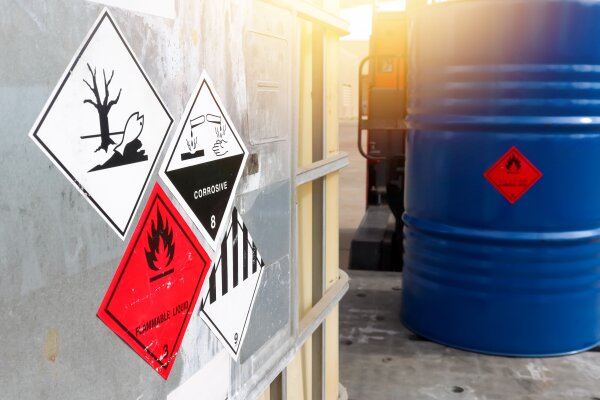TRGS 510: the technical rules for the storage of hazardous substances in portable containers.

The resolutions and announcements of the TRSG (Technical Rules for Hazardous Substances) specify and summarize measures for handling hazardous substances. The storage class TRGS 510 refers to the storage of hazardous substances in portable containers. Read here how this technical regulation is structured and which specifications apply.
What is the TRGS?
If a TRGS is mentioned, it is a technical rule for hazardous substances. These are published by the Federal Institute for Occupational Safety and Health (baua) and determined and adapted by the Committee for Hazardous Substances (AGS). The TRGS define theclassification, labeling and activitywith substances of the various classes of hazardous materials, based on validated occupational health findings and the current state of the art as well as occupational hygiene.
In addition to general instructions, the TRGS are divided into 6 categories(TRGS 200, 400, 500, 600, 700 and 800 as well as 900) and further published decisions. TRGS 500 specifies protective measures for activities involving hazardous substances – TRGS 510 specifies for the storage of hazardous substances in portable containers. It consists of 13 sections and two annexes, as well as three other regulations.
The regulations of TRGS 510
The storage of hazardous substances in portable containers is prescribedin the 13 sections and two annexesof TRGS 510, which is summarized in the PDF of baua. The corresponding TRGS 510 PDF can be found under this link – it forms the basis for the following explanations.
1. Scope of application
In the first section – the scope of application – it is explained that TRGS 510 applies to the storage of hazardous substances in portable containers, covering in particular storage and retrieval, transport within the storage facility and the disposal of released hazardous substances. Excluded areas of application are also explained, for example, where this Technical Rule for Hazardous Substances does not apply. Table 1 contains classifications of the substances with regard to their net storage quantity.
2. Definitions
In the definition of terms, reference is made to the regulations of the Ordinance on Industrial Safety and Health, the Ordinance on Biological Substances and the Ordinance on Hazardous Substances, which defines all important terms of this Technical Rule. In addition, the meaning frames of the terms
- Distance,
- Aerosol pack,
- Fire Protection,
- Compressed Gas Vessels,
- potentially explosive atmospheres,
- Small quantities,
- Bearing
and some more explained. This provides the necessary basis for the following sections and appendices.
3. Risk assessment
The third section includes the risk assessment, which must be carried out by every employer in accordance with §5 of the Occupational Health and Safety Act and §6 of the Hazardous Substances Ordinance (GefStoffV). Thus, it must be determined to what extent hazards to employees and other persons result from the storage of these substances. For the performance of this assessment, reference is made to TRGS 400.
The basis includes properties of the hazardous substances (such as aggregate state, quantity, type of storage, activity during storage, combination and working as well as environmental conditions) as well as activities such as storage and retrieval, transport within the warehouse and removal of released hazardous substances.
4. General measures
The general measures are summarized in section 4 of the TRGS on the storage of hazardous substances and are divided into three subsections:
-
4.1 Principles: This lists the measures that must be implemented to maximize the reduction of risk to the health and safety of persons. The same applies to a risk to the environment from substance-related damage.
-
4.2 General protective measures for the storage of hazardous substances:This subitem lays down rules for the nature of portable containers and also prescribes what to look out for during storage.
- 4.3 Access restrictions for special hazardous substances:Special hazardous substances that are acutely toxic, carcinogenic, germ cell mutagenic or specifically target organ toxic are subject to further access restrictions. These are defined in section 4.3 and include, for example, safety briefings.
5. Additional protective measures for storage in warehouses
Section 5 defines broadening protective measures, which in turn can be differentiated into nine subsections:
-
5.1 Scope and general measures:Explanation of Table 2, which indicates the storage quantity of hazardous substances according to TRGS 510.
-
5.2 Storage organization: Organizational measures for storage including accessibility, emergency equipment, storage quantities, storage sections and behavioral measures.
-
5.3 Securing of the stored goods: labeling of dangerous goods, characteristics of storage facilities and specifications for stacking and securing the portable containers.
-
5.4 Instruction of employees: Instruction with information on potentially occurring hazards and written operating instructions.
-
5.5 Measures for alerting: It must be possible to leave the workplace in case of immediate significant danger.
-
5.6 Personal Protective Equipment:This equipment is to be provided by the employer and must meet the requirements for the hazardous materials involved.
-
5.7 Hygienic measures:Avoidance of absorption of the hazardous substances by skin contact, oral intake or inhalation must be ensured.
-
5.8 First aid measures:According to §13 paragraph 1 GefStoffV, measures must be taken that are necessary for first aid.
- 5.9 Inspections and checks:For example, checking for damage to containers including documentation.
6. Special fire protection measures
Section 6 summarizes in Table 3 the hazardous materials for which special fire protection measures are required during storage. In addition, there are regulations on the structural fire protectionof the warehouse and on measures to be taken in the event of an incident. The properties of escape routes must also comply with the requirements of TRGS 510, which are specified in this section.
7. additional measures for special hazardous substances
Table 4, which can be found in Section 7 of the Technical Rule for Hazardous Substances 510, defines special hazardous substances with additional required measures that must be handled separately above a certain net storage quantity. Allnecessary procedures– such as those relating to building requirements, fire protection and precautions for operational disruptions – are noted here. Thus, a plan for emergency response must be in place.
8. storage of acutely toxic hazardous substances
The same applies to the storage of hazardous substances that have acute toxic properties. These substances are also summarized in a table (Table 5) and assigned with their net storage quantity. There are also separate building requirements and fire protection measures for acutely toxic substances.
9. Storage of oxidizing liquids and solids
Third in the group are oxidizing liquids and solids, which are listed by type of hazardous substance in Table 6 in the 9th section of hazardous substance storage of TRGS 510. When storing these hazardous substances, special safety cabinets must be used in accordance with Annex 1. In addition, constructional requirements and measures for fire protection are again included, which must be observed for this hazardous material storage. This includes, for example, certain bearing sections.
10. Storage of gases under pressure
According to TRGS 510, Section 10 includes, for example, the storage of hazardous substances in gas cylinders, where separate organizational measures are required. This includes, among other things, securing the pressurizedgas containers against falling over or down, but also the location of storage, the prohibition of transfer within the warehouse and the designated areas for TRGS 510 gas cylinders are included. Here, too, there are regulations on fire protection, building requirements and special protective measures.
11. Storage of compressed gas cartridges and aerosol dispensers
The storage of aerosol cans according to TRGS 510, for example, is a component of Section 11, which deals with the storage of compressed gas cartridges and aerosol packages. According to Table 8, this mainly includes substances of the CLP Regulation that correspond to the hazard statements H220 to H223 and H229. For example, net storage quantities of 100 tons per storage room may not be exceeded unless separate protective measures are in place.
12. Storage of flammable liquids
The storage of hazardous substances also includes the storage of flammable liquids, which is dealt with in Section 12 of this Technical Rule for Hazardous Substances. Table 9 defines the substances H224 to H226 as hazard statements according to the CLP Regulation.
For the storage of flammable liquids according to TRGS 510, permissible storage quantities, structural requirements and a certain fire protection of storage rooms are prescribed, which can be found here. In addition, there are distances, instructions for outdoor storage and restraint devices as well as measures for explosion protection.
13. Combined storage, separate storage and separate storage
Section 13 defines the overall situation with regard to the combined storage, separate storage and separate storage of the same and different hazardous substances in accordance with TRGS 510. For this purpose, in addition to general principles, special storage tableshave been listed that clearly summarize permits and prohibitions. The last section of this 13th item is devoted to specific and deviating regulations.
Annex of the TRGS 510
In addition to the 13 sections, there are two annexes introduced with the February 2021 revision of TRGS 510. These include in Annex 1 the storage in safety cabinets and in Annex 2 an assignment of storage classes including assignment guidelines.
Storage in safety cabinets (1)
Annex 1 on the storage of hazardous substances in safety cabinets is divided into a scope of application, general requirements and ventilation of this form of storage. Includes mainly a concretization of the requirements from sections 4, 5 and 12 as well as example 2.11.2 and other liquid hazardous substances. The necessary characteristics of the safety cabinets are described, which primarily refers to fire resistance, condition and operating instructions.
Assignment of the bearing classes (2)
Annex 2 specifies how hazardous substances can be assigned to the individual storage classes (LGK). On the one hand, this is the basis for determining the possibilities forcombined storage, and on the other hand, it is the standard for labeling into main hazards and secondary hazards in accordance with hazardous materials law. The storage classes are listed in section A.2.2 of Annex 2 as an allocation guide.
Further regulations in TRGS 510
In addition, there are further regulations in TRGS 510 that relate to small quantities, storage bans and protective as well as preventive measures. These also relate to the protection of workers and the prevention of a release of hazardous substances.
Regulations for small quantities in TRGS 510
A hazardous substance is considered a small quantity if the maximum weight of 1,500 kg is not exceeded – regardless of where this total net mass is stored. This may include, for example, buildings, rooms or safety cabinets. In addition, however, there are limits for individual substances for which other definitions of small quantities apply.
For flammable liquids, the limit is already 1,000 kg, while for highly flammable liquids, the maximum weight is specified as 20 kg – already above this amount, the liquid may no longer be stored outside a special warehouse. For flammable hazardous materials, 10 kg applies.
Storage prohibitions in TRGS 510
There are also special storage bans for hazardous substances in TRGS 510, which has a practical background. Hazardous substances, for example, must primarily be stored where they are in good hands from a fire protection point of view and where they fit into the production process. Storage is allowed in work rooms only if there is consent of the workers and if the quantities are small.
The situation is different, of course, in the case of extremely toxic or even carcinogenic substances, which again do not allow any exceptions – such as storage in workrooms. These hazardous substances must be kept under lock and key in accordance with TRGS 510.
Protection and prevention measures in TRGS 510
Not only large quantities, but also small quantities of hazardous substances remain dangerous. For this reason, TRGS 510 specifies protective and preventive measures that comply with the requirements of the Ordinance on Hazardous Substances (GefStoffV). In addition to the clear identifiabilityof stored substances, this also includes leak-proof containers, a distinctive feature with food containers and personal protective clothing for workers, as well as measures to protect the environment.
Innovations in TRGS 510
In December 2020, the Technical Regulation for the Storage of Hazardous Substances in Transportable Containers was revised and the amendment was published in February 2021. In particular, the requirements of the Ordinance on Hazardous Substances (GefStoffV) were specified in TRGS 510 – thus raising the safety standard. These regulations and chapters were particularly affected:
-
Section 4: The regulations for access restrictions in Section 4.3 have been summarized and supplemented with requirements for access restrictions in industrial parks.
-
Section changes: The former section 5 is now found under section 7. What was previously Section 7 has shifted to Section 13. This allowed the numbering to be retained.
-
Section 13: These storage requirements do not apply until storage also occurs in the warehouse. At the same time, the storage class designations were deleted to correspond to the assignment in the flow chart running Annex 2.
-
Annexes: The old Annexes 1 and 2 are no longer applicable; instead, Annex 3 to the new Annex 1 (storage in safety cabinets), Annex 4 to the new Annex 2 (allocation to storage classes) and Annex 5 have been integrated into Section 12.
- General changes: The amendment also includes an addition regarding the holding of hazardous substances in larger quantities. In addition, old references to the classifications according to the substance directive 67/548/EEC have been deleted.
Hazardous substance regulations such as TRGS 510 are indispensable in operation
In order to be able to ensure the safety and protection of persons when handling hazardous substances, compliance with measures from the TRGS is essential. The maxims contained therein are based on the latesttechnical, scientific and occupational health standards. Anyone who knows the classifications, labels and requirements there is on the safe side when storing hazardous substances in transportable containers.
Do you have questions about the topic or would you like to suggest a topic? Please contact us by phone at +49 30 2096579 00 or send us an email at info@medsolut.com.




